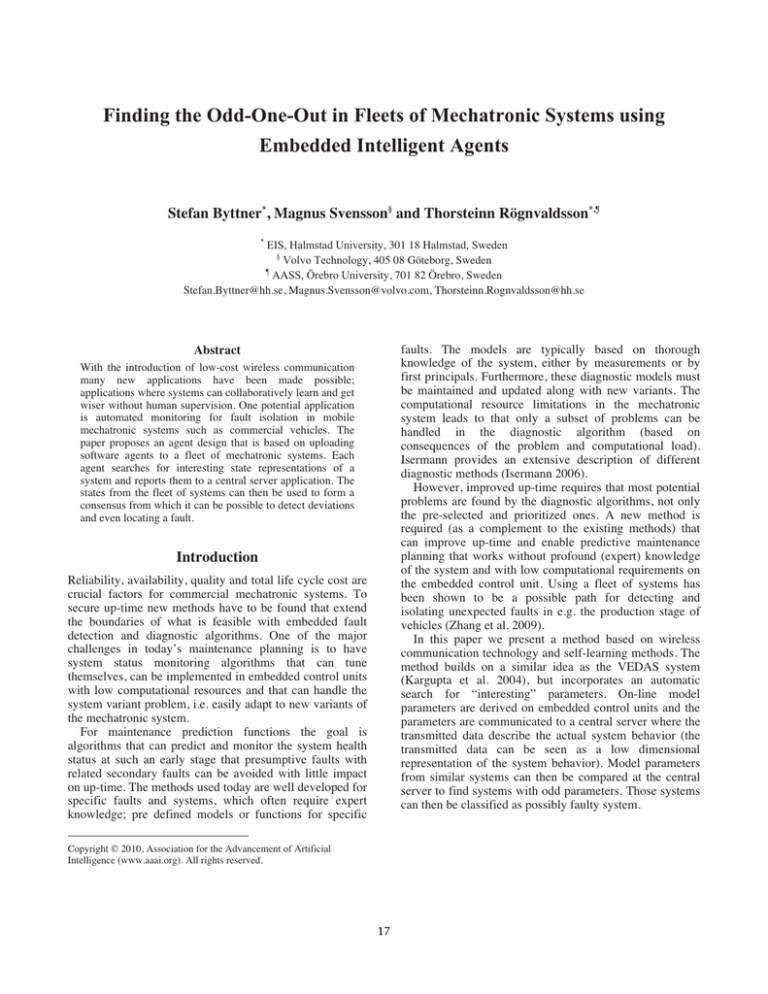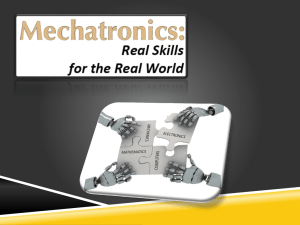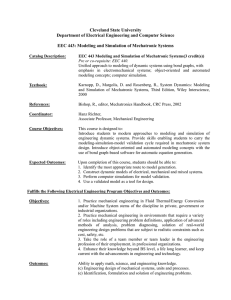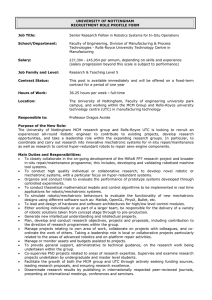
Finding the Odd-One-Out in Fleets of Mechatronic Systems using
Embedded Intelligent Agents
Stefan Byttner*, Magnus Svensson§ and Thorsteinn Rögnvaldsson*,¶
*
EIS, Halmstad University, 301 18 Halmstad, Sweden
§
Volvo Technology, 405 08 Göteborg, Sweden
¶
AASS, Örebro University, 701 82 Örebro, Sweden
Stefan.Byttner@hh.se, Magnus.Svensson@volvo.com, Thorsteinn.Rognvaldsson@hh.se
faults. The models are typically based on thorough
knowledge of the system, either by measurements or by
first principals. Furthermore, these diagnostic models must
be maintained and updated along with new variants. The
computational resource limitations in the mechatronic
system leads to that only a subset of problems can be
handled in the diagnostic algorithm (based on
consequences of the problem and computational load).
Isermann provides an extensive description of different
diagnostic methods (Isermann 2006).
However, improved up-time requires that most potential
problems are found by the diagnostic algorithms, not only
the pre-selected and prioritized ones. A new method is
required (as a complement to the existing methods) that
can improve up-time and enable predictive maintenance
planning that works without profound (expert) knowledge
of the system and with low computational requirements on
the embedded control unit. Using a fleet of systems has
been shown to be a possible path for detecting and
isolating unexpected faults in e.g. the production stage of
vehicles (Zhang et al. 2009).
In this paper we present a method based on wireless
communication technology and self-learning methods. The
method builds on a similar idea as the VEDAS system
(Kargupta et al. 2004), but incorporates an automatic
search for “interesting” parameters. On-line model
parameters are derived on embedded control units and the
parameters are communicated to a central server where the
transmitted data describe the actual system behavior (the
transmitted data can be seen as a low dimensional
representation of the system behavior). Model parameters
from similar systems can then be compared at the central
server to find systems with odd parameters. Those systems
can then be classified as possibly faulty system.
Abstract
With the introduction of low-cost wireless communication
many new applications have been made possible;
applications where systems can collaboratively learn and get
wiser without human supervision. One potential application
is automated monitoring for fault isolation in mobile
mechatronic systems such as commercial vehicles. The
paper proposes an agent design that is based on uploading
software agents to a fleet of mechatronic systems. Each
agent searches for interesting state representations of a
system and reports them to a central server application. The
states from the fleet of systems can then be used to form a
consensus from which it can be possible to detect deviations
and even locating a fault.
Introduction
Reliability, availability, quality and total life cycle cost are
crucial factors for commercial mechatronic systems. To
secure up-time new methods have to be found that extend
the boundaries of what is feasible with embedded fault
detection and diagnostic algorithms. One of the major
challenges in today’s maintenance planning is to have
system status monitoring algorithms that can tune
themselves, can be implemented in embedded control units
with low computational resources and that can handle the
system variant problem, i.e. easily adapt to new variants of
the mechatronic system.
For maintenance prediction functions the goal is
algorithms that can predict and monitor the system health
status at such an early stage that presumptive faults with
related secondary faults can be avoided with little impact
on up-time. The methods used today are well developed for
specific faults and systems, which often require expert
knowledge; pre defined models or functions for specific
Copyright © 2010, Association for the Advancement of Artificial
Intelligence (www.aaai.org). All rights reserved.
17
The approach requires finding a suitable metric and
distribution estimation method for the model parameters.
For linear models, we have previously used a single
Gaussian model for modeling the distribution and
Mahalanobis distance as a metric (Byttner et al. 2009). If
the models are principal component subspaces then an
angle based similarity measure is more suitable
(Rögnvaldsson et al. 2008); if the models are selforganized maps then a different distance may be
appropriate (Svensson, Byttner and Rögnvaldsson 2008).
Strategy for Intelligent Agent Based Fault
Detection
There are three steps in the proposed procedure; (1)
searching for “interesting” relations on the internal
network of a mechatronic system, (2) using the found
relations for detecting deviations; and (3) locate the actual
fault on the deviating system.
Searching for interesting relations
The first step involves searching for representations of a
certain systems state. This can be realized by uploading a
search-agent to an embedded control unit in each of the
available mechatronic systems. The agent can there search
for “interesting” relations on the internal data buses. In
general, relations that do not appear to be random can
potentially be interesting relations to monitor. The relations
can be modeled in the agent using e.g. linear models, autoencoders or self-organizing maps. Judging if a relation
appears to be non-random can e.g. be done using
correlation coefficients or fitness errors in the case of
linear models, and spread (distortion) measures in the case
of a clustering technique.
If the agents find interesting relations then they report
them back to a central server application. The application
will then select some of the found relations depending on
the “interestingness”, e.g. fitness error. The configuration
for the selected relations is then sent to all mechatronic
systems for continuous fitting (adaptation) of their model
parameters, and they then regularly send the parameters
back to the central server application using wireless
communication.
The point with sending relationships between signals
between the mechatronic systems and the back-office
server, rather than raw data, is that this requires much less
wireless traffic.
Fault localization on systems with deviating model
parameters
The transmitted data from the on-line models can be used
to locate the cause of the problem. The limited amount of
information in the transmitted parameters can be used to
build a fault dictionary that learns to tie specific parameter
combinations to specific faults. This can be done, e.g., by
connecting the service histories of the vehicles to the
observed time trace of signal relations.
Another way to find the cause of the problem is to use
simulation models of the system to replicate the behavior
of the system, by adapting the model to the model
parameters transmitted from the real system. This means
that the simulations can be run off-board and only the
relations between signals are compared between the
simulation and the real system. At the central server the
available computational power is large, which enables the
usage of advanced models. This also allows easier
maintenance and upgrading of the fault isolation hardware.
Summary
With increased requirements on managing up-time and to
secure that service is done when actually needed there is a
need to monitor individual systems health conditions. A
method has been proposed where embedded intelligent
agents are used for learning how similar systems behave
through deriving on-line model parameters and transmit
them to a central server for analysis and comparison with
similar systems. By comparing each system’s model
parameters with the norm (defined by the other system
parameters) possible faulty systems can be detected.
The method essentially tries to build a self-learning
system that incorporates the exploratory data analysis that
a human expert performs when learning about a problem.
In its current form the explored relationships are very
simple, yet effective, but we envision that it can be
expanded with more complex models for the relationships.
The core idea is to have a collaboratively learning group of
systems.
We believe that a method like this (which is based on
self-learning methods and comparison between similar
systems) has potential to improve mechatronical system
monitoring, by providing a way to predict and locate
presumptive faults and to be used as a method for
predictive maintenance.
Detecting deviations in found relations
When the mechatronic systems are continually fitting the
model parameters of the interesting relations, it is possible
to monitor the parameter values in the central server
application. The purpose is to detect deviations in model
parameters, e.g. using a cross-validation technique. In
essence, this means that a model parameter set for one
system (returned from one of the mechatronic systems) is
tested if it belongs to the group of model parameters from
the other systems. The group can consist of the model
parameters of all the other systems or a subset of all
systems. The test procedure is then repeated for all the
systems, to calculate the probability that a system belongs
to the distribution given by the group (all the other
systems). A low probability for belonging to the group
indicates a deviating system, which can potentially be a
faulty system. The underlying assumption here is that most
of the monitored systems have normal (non-faulty)
functionality.
18
References
Isermann R., 2006. Fault-diagnosis systems. Berlin
Heidelberg: Springer-Verlag.
Byttner S., Rögnvaldsson T., Svensson M., Bitar G.,
Chominsky W., 2009. Networked vehicles for automated
fault detection. IEEE International Symposium on Circuits
and Systems. Taipei, Taiwan.
Rögnvaldsson T., Panholzer G., Byttner S., and Svensson
M., 2008. A self-organized approach for unsupervised fault
detection in multiple systems, Proc. 19th International
Conference on Pattern Recognition, (ICPR 2008), Tampa,
Florida, Dec. 8-11, vols. 1-6, pp. 3775–3778.
Svensson M., Byttner S., Rögnvaldsson T., 2008. SelfOrganizing Maps for Automatic Fault Detection in a
Vehicle Cooling System. 4th International IEEE
Conference “Intelligent Systems”. Varna, Bulgaria.
Zhang Y., Gantt G., Rychlinski M., Edwards R., Correia J.,
and Wolf C., 2009. Connected vehicle diagnostics and
prognostics, concept, and initial practice. IEEE trans. on
reliability, vol. 58, no. 2.
Kargupta H., Bhargava R., Liu K., Powers M., Blair P.,
Bushra S., Dull J., Sarkar K., Klein M., Vasa M., Handy
D., 2004. VEDAS: A Mobile and Distributed Data Stream
Mining System for Real-Time Vehicle Monitoring, Proc.
of the 2004 International SIAM Data Mining Conference.
19





